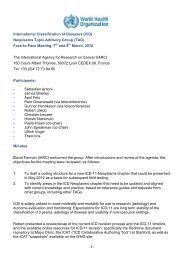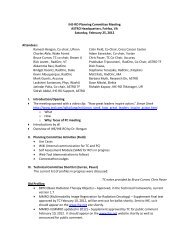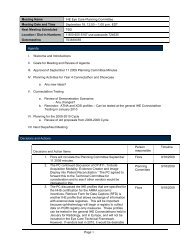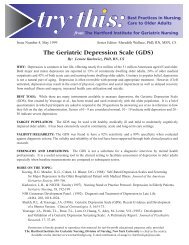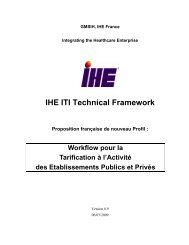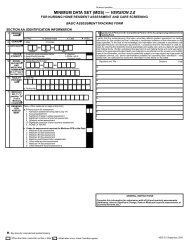SNOMED CT in Pathology - IHE Wiki
SNOMED CT in Pathology - IHE Wiki
SNOMED CT in Pathology - IHE Wiki
You also want an ePaper? Increase the reach of your titles
YUMPU automatically turns print PDFs into web optimized ePapers that Google loves.
<strong>SNOMED</strong> <strong>CT</strong> <strong>in</strong> <strong>Pathology</strong>Marcial García RojoHospital General Universitario de Ciudad Real. Spa<strong>in</strong><strong>IHE</strong> AP. Paris, June 2 nd , 2012
Background<strong>SNOMED</strong> <strong>CT</strong> useful <strong>in</strong>:• Reference term<strong>in</strong>ology: Information Systems (IS)<strong>in</strong>tegration (semantic <strong>in</strong>teroperability)◦ EHR – <strong>Pathology</strong> IS• Electronic request <strong>Pathology</strong> Study (specimens, anatomy)• <strong>Pathology</strong> report available <strong>in</strong> EHR (diagnosis, cl<strong>in</strong>ical problems,episode cod<strong>in</strong>g-bill<strong>in</strong>g)◦ <strong>Pathology</strong> IS and telepathology portal (specimens anddiagnosis)◦ <strong>Pathology</strong> IS and DICOM image manager (specimens anddiagnosis)◦ <strong>Pathology</strong> IS and hospital tumor registry, biobank IS,…• Interphase term<strong>in</strong>ology◦ Searches made easier, Concept navigation, Qualifiers can beadded, synonyms are available
<strong>Pathology</strong> reports•Free text reports◦Cod<strong>in</strong>g specimens (procedures?), anatomy anddiagnosis•Structured reports◦Cod<strong>in</strong>g both the question and the answer•Question: Observable entity (Histological grade?)•Answer: Diagnosis and qualifiers
procedurespecimenprocedurespecimenprocedurespecimencl<strong>in</strong>ical f<strong>in</strong>d<strong>in</strong>gspecimen
Cod<strong>in</strong>g specimens• Spanish Society of Anatomic <strong>Pathology</strong> (SEAP):Consensus from 8 <strong>in</strong>stitutions from all over Spa<strong>in</strong>.• Criteria for classify<strong>in</strong>g specimens (withoutconsideration of workload or diagnosis)1. General topography (sk<strong>in</strong>)2. Obta<strong>in</strong><strong>in</strong>g procedure or <strong>in</strong>tention: In biopsies• Superficial biopsy (punch, tru-cut or needle)• Incisional biopsy• Enucleation• Complete excision (generally with adjacent tissue)• Partial resection of an organ• Complete removal of an organ• Removal of organ and adjacent structures (e.g. lymphadenectomy)• Special resection (Whipple, abdom<strong>in</strong>oper<strong>in</strong>eal,…) o method(stereotactic, endoscopy)
Cod<strong>in</strong>g specimens•Cytology◦Exfoliative cytology, brush<strong>in</strong>gs or scrap<strong>in</strong>gs◦Fluid sample◦Touch preparation◦F<strong>in</strong>e Needle Aspiration (FNA)•Autopsy◦Coded as procedures
Results of cod<strong>in</strong>g specimens andprocedures with <strong>SNOMED</strong> <strong>CT</strong>•Biopsies: 345 specimens and procedures◦112 specimens (32%) post-coord<strong>in</strong>ated◦47 procedures (14%) post-coord<strong>in</strong>ated•Cytologies: 206 specimens and procedures◦73 specimens (35%) post-coord<strong>in</strong>ated◦92 procedures (46%) post-coord<strong>in</strong>ated•Autopsies: 21 different procedures (3 postcoord<strong>in</strong>ated)
Guidel<strong>in</strong>es for cod<strong>in</strong>g with<strong>SNOMED</strong> <strong>CT</strong>• What to do when 2 similar codes are found(choose the most specific one).◦ 128157004 |tissue specimen from bra<strong>in</strong> (specimen)|better than119398007 |specimen from bra<strong>in</strong> (specimen)|◦ 438351003 | tissue specimen obta<strong>in</strong>ed by esophagogastrectomy(specimen) |<strong>in</strong>cludes:122631007 | specimen from esophagus obta<strong>in</strong>ed byesophagogastrectomy (specimen) |• “esophageal biopsy sample” or “tissuespecimen from esophagus”? “tissuespecimen” was preferred
Guidel<strong>in</strong>es for cod<strong>in</strong>g specimenswith <strong>SNOMED</strong> <strong>CT</strong>• specimen from __(topography)__ obta<strong>in</strong>ed by __(procedure)__Where procedure “biopsy”. Procedure can be general (“excision”)or very specific (“Whipple resection | subtotal adrenalectomy”). (229concepts)• specimen from __(topography)__ obta<strong>in</strong>ed by __( |core|excisional |image guided core |<strong>in</strong>cisional |open |…)__ biopsyVery specific procedures, from “<strong>in</strong>cisional biopsy” to “stereotacticallyguided core needle biopsy” or “<strong>CT</strong> guided needle biopsy”. (55concepts).• specimen from __(topography)__ obta<strong>in</strong>ed by biopsy(specimen)Biopsy type is not stated. (46 concepts)• (topography)__ biopsy sample(75 concepts).• tissue specimen from__(topography)__(62 concepts)
Postcood<strong>in</strong>ation rulesRef<strong>in</strong>ement (C:A=V) (C:A 1 =V 1 ,A 2 =(V 2 ),…,A n =V n )• Specimens:◦ specimen : specimen procedure (attribute) = procedure◦ specimen : specimen source topography (attribute) = bodystructure◦ specimen :specimen source topography (attribute) = body structure ,specimen procedure (attribute) = procedure• Procedures:◦ procedure : procedure site - Direct (attribute) = body structure
Very specific anatomic regions•Very few precoord<strong>in</strong>ated terms are veryspecific (post-coord<strong>in</strong>ated needed)◦122683000 | specimen from left kidney, <strong>in</strong>feriorpole obta<strong>in</strong>ed by partial nephrectomy(specimen) |•A specific topographic code may be foundas precoord<strong>in</strong>ated:◦12212007 | structure of superior segment of leftlower lobe of lung (body structure) |
Laterality118169006 | specimen source topography (attribute) |272741003 | laterality (attribute) |Values admitted by this attribute are descendants from theconcept: 182353008 | side (qualifier value) |:◦ 7771000 | left |• 51440002 | right and left |• 419161000 | unilateral left |◦ 24028007 | right |• 51440002 | right and left |• 419465000 | unilateral right |
Implementation of specific sitesand laterality•It may be easier implement<strong>in</strong>g a databasefield “topography” coded with <strong>SNOMED</strong><strong>CT</strong> than post-coord<strong>in</strong>at<strong>in</strong>g specimens orprocedures with this attribute.
A possible error <strong>in</strong> <strong>SNOMED</strong> <strong>CT</strong>•“122622007 | specimen from pleuraobta<strong>in</strong>ed by lymph node biopsy |”•(<strong>in</strong>cluded as a descendant of “pleurabiopsy sample”)
Add<strong>in</strong>g new conceptsMS Access file(BatchRequestGeneral_MSSSI_Spa<strong>in</strong>_06032012.mdb)• Submit Date• Submitter ID• Proposed FSN• Parent ConceptID• Parent FSN• Submitter Comment• Editor Action• "Reject": Reason• "Added": UUID• "Added with NameChange": FSN• Name ChangeReason• "Found": ConceptID• "Found": FSN• Editor Comment
Cod<strong>in</strong>g <strong>Pathology</strong> diagnosis•Pathologists should become aware of thestructure and contents of <strong>SNOMED</strong> <strong>CT</strong>•A shift from T, P, M schema to apolihierarchy and relationship schema•Pathologist’ diagnosis should be coded asmorphology (abnormal body structure) oras cl<strong>in</strong>ical diagnosis?
CAP Anatomic <strong>Pathology</strong> SubsetHierarchyApproximate CountBody structure 3,805Cl<strong>in</strong>ical F<strong>in</strong>d<strong>in</strong>g 2,024Procedure 780Observable entity 386Specimen 264Pharmaceutical / Biologic product 83Record artifact 67Organism 61Stag<strong>in</strong>g and scales 33Substance 24Qualifier value 21Special concept 12Events 9Situation with explicit context 9Physical object 4TOTAL CONCEPTS (Jan 2010) 7,582In daily practice, this subset was not considered useful by pathologists, ma<strong>in</strong>lydue to the mixture of different hierarchies (cl<strong>in</strong>ical f<strong>in</strong>d<strong>in</strong>gs, body structure,observations,..), and due to the fact that many basic pathology diagnosis werenot <strong>in</strong>cluded <strong>in</strong> the CAP AP Subset.
Implementation of <strong>SNOMED</strong> <strong>CT</strong> <strong>in</strong>Hospital General de Ciudad Real•<strong>IHE</strong>: Structured Reports Value Sets (1,840possible values for observations)•HGUCR: 2,320 pathology diagnosis codesmapped to <strong>SNOMED</strong> <strong>CT</strong>• Search for descriptions that match the locallegacy codes was performed us<strong>in</strong>g Cl<strong>in</strong>iClueXplorer version 2010 1.243, us<strong>in</strong>g <strong>SNOMED</strong> <strong>CT</strong>2011-01-31 International Release and 2010-04-30 Spanish Edition.
Results. Implementation of <strong>SNOMED</strong><strong>CT</strong>. Hierarchies of precoord<strong>in</strong>ated terms•Postcoord<strong>in</strong>ation needed <strong>in</strong> 19% (3conceptID needed only rarely) (81%precoord<strong>in</strong>ated)•Morphology – Abnormal body structure◦Only 44% of the codes! (1076)•Cl<strong>in</strong>ical f<strong>in</strong>d<strong>in</strong>gs◦48% of the codes•Qualifiers, normal anatomic structures,procedures, physical object, substance,organism◦10% of the codes
Results•48% of the total terms could be codedus<strong>in</strong>g the disorder hierarchy, us<strong>in</strong>g:◦In 1104 terms, us<strong>in</strong>g “disorder” hierarchy, e.g.Rosacea◦In 71 terms, us<strong>in</strong>g “f<strong>in</strong>d<strong>in</strong>g” hierarchy, e.g.World Health Organization (WHO) grade I(central nervous system tumor)
Results• There were a 6% of the local morphologicaldiagnosis that were not well represented us<strong>in</strong>geither morphological abnormality ordisorder/f<strong>in</strong>d<strong>in</strong>g hierarchies, and the follow<strong>in</strong>g<strong>SNOMED</strong> <strong>CT</strong> were found useful (generallycomb<strong>in</strong>ed with other hierarchies):◦In 95 local terms, the use of a <strong>SNOMED</strong> <strong>CT</strong> qualifiers(generally comb<strong>in</strong>ed with cl<strong>in</strong>ical or morphologicalcodes) was found useful, e.g. Granulomatous◦In 68 local terms, the use of <strong>SNOMED</strong> <strong>CT</strong> bodystructures was found useful, e.g. Undescended testis◦…
Postcoord<strong>in</strong>ation <strong>in</strong> practice•Initially, <strong>in</strong> case a comb<strong>in</strong>ation of termswas needed, the <strong>in</strong>itial comb<strong>in</strong>ation ofterms was made without consider<strong>in</strong>g<strong>SNOMED</strong> <strong>CT</strong> rules for post-coord<strong>in</strong>ation,but consider<strong>in</strong>g the best comb<strong>in</strong>ation ofterms that def<strong>in</strong>e the concept accord<strong>in</strong>g topathologists’ idea.
AttributesBody StructureLateralityCl<strong>in</strong>ical F<strong>in</strong>d<strong>in</strong>gAssociated With• After• Causative Agent• Due ToAssociatedMorphologyCl<strong>in</strong>ical CourseEpisodicityF<strong>in</strong>d<strong>in</strong>g InformerF<strong>in</strong>d<strong>in</strong>g MethodF<strong>in</strong>d<strong>in</strong>g SiteHas Def<strong>in</strong>itionalManifestationHas InterpretationInterpretsOccurrencePathological ProcessSeverityEventsAssociated With• After• Causative Agent• Due ToOccurrenceEvaluation ProcedureComponentHas SpecimenMeasurement MethodPropertyScale TypeTime AspectPharmaceutical/Biologic ProductHas Active IngredientHas Dose FormPhysical ObjectHas Active IngredientProcedureAccessDirect SubstanceHas FocusHas IntentMethodPriorityProcedure Device• Direct Device• Indirect Device• Us<strong>in</strong>g AccessDevice• Us<strong>in</strong>g DeviceProcedureMorphology• DirectMorphology• IndirectMorphologyProcedure Site• Procedure Site –Direct• Procedure Site –IndirectRecipient CategoryRevision StatusRoute of Adm<strong>in</strong>istrationSurgical ApproachUs<strong>in</strong>g EnergyUs<strong>in</strong>g SubstanceSituation with ExplicitContextAssociated F<strong>in</strong>d<strong>in</strong>gAssociated ProcedureF<strong>in</strong>d<strong>in</strong>g ContextProcedure ContextSubject RelationshipContextTemporal ContextSpecimenSpecimen ProcedureSpecimen SourceIdentitySpecimen SourceMorphologySpecimen SourceTopographySpecimen Substance
Postcoord<strong>in</strong>ation• Morphological concepts (morphologicallyabnormal structure) are primitive terms (not“sufficiently” def<strong>in</strong>ed) and CANNOT bepostcoord<strong>in</strong>ated• CILLIATED CELL ADENOCARCINOMA• 35917007 + 125550007◦35917007 | Adenocarc<strong>in</strong>oma, no subtype (morphologicabnormality)◦125550007 | Tubal metaplasia (morphologicabnormality)
An example of lack of coherence <strong>in</strong><strong>SNOMED</strong> <strong>CT</strong>• The concept “well differentiatedadenocarc<strong>in</strong>oma” is not available as precoord<strong>in</strong>atedterm <strong>in</strong> <strong>SNOMED</strong> <strong>CT</strong> <strong>in</strong> either bodystructure or <strong>in</strong> cl<strong>in</strong>ical f<strong>in</strong>d<strong>in</strong>g hierarchies.However, there are available some morespecific similar codes like “follicularadenocarc<strong>in</strong>oma, well differentiated(morphologic abnormality)” or “well differentiatedadenocarc<strong>in</strong>oma, gastric foveolar type(morphologic abnormality)”.
Spanish Subset for Diagnosis•Specimen and Procedure subset ispublished <strong>in</strong> http://www.seap.es/•The Spanish Society of Anatomic<strong>Pathology</strong> is currently work<strong>in</strong>g <strong>in</strong> apathology diagnosis subset that will bepublished next October.
<strong>Pathology</strong> IS and <strong>SNOMED</strong> <strong>CT</strong>
Structured pathology reports• The general approach to cod<strong>in</strong>g items on theCAP and <strong>IHE</strong> checklist that ask questions hasbeen to use concepts from the <strong>SNOMED</strong> <strong>CT</strong>Observable Entity hierarchy.• The answers to these questions can be chosenfrom concepts <strong>in</strong> any of several hierarchies.Primarily, they are found <strong>in</strong> the F<strong>in</strong>d<strong>in</strong>g,Disorder, or Morphologic Abnormalityhierarchies (van Berkum, 2003).
Why we like morphological codes• As pathologists, we feel the need to have ourpathology reports encoded us<strong>in</strong>g not onlyobservables (questions) and qualifiers (valuesets), but ma<strong>in</strong>ly us<strong>in</strong>g morphological codes thatsummarize all observations described <strong>in</strong> thereport.• Therefore, the section of the pathologydedicated to cod<strong>in</strong>g should conta<strong>in</strong> a list ofmorphological codes associated with thecorrespond<strong>in</strong>g specimen.
Cl<strong>in</strong>ical f<strong>in</strong>d<strong>in</strong>gs preferred by EHR•In electronic health record studies, thecl<strong>in</strong>ical f<strong>in</strong>d<strong>in</strong>gs should generally bepreferred over the morphologicabnormality concept. In case there is onlya morphologic abnormality concept, itshould be post-coord<strong>in</strong>ated with a focusconcept of "64572001|Disease (disorder)|"and l<strong>in</strong>ked with the concept model attribute"116676008|Associated morphology(attribute)|" (Lee, 2010).
Precoord<strong>in</strong>ated primitive terms•Whenever a pre-coord<strong>in</strong>ated concept isavailable, that should be the first choice. Ifthe pre-coord<strong>in</strong>ated concept is a primitiveconcept, an alternative is to create a postcoord<strong>in</strong>atedexpression to ensure thenecessary semantics are recorded. Thereason is that terms encoded with primitiveconcepts are more difficult to query andtest for equivalency (Lee, 2010).
L<strong>in</strong>kage concepts <strong>in</strong> <strong>Pathology</strong>• The concept “histological grade (attribute)” is a l<strong>in</strong>kageconcept.• There are some special concepts, like attributes (e.g.246229000 | histological grade (attribute)), that can beused as “l<strong>in</strong>kage concepts”:• Question: 371469007 | histologic grade (observableentity),246229000 | histological grade (attribute)• Answer (values):370114008 | histological grades (qualifier value):384812005 | moderately differentiated263843001 | poorly differentiated263918006 | undifferentiated263933003 | well differentiated
L<strong>in</strong>kage concepts•Associated morphology is one of thel<strong>in</strong>kage concepts (attributes) used todef<strong>in</strong>e cl<strong>in</strong>ical f<strong>in</strong>d<strong>in</strong>gs concepts.Associated morphology attributes specifythe morphologic changes seen at thetissue or cellular level that arecharacteristic features of a disease.
Morphology attributes• <strong>SNOMED</strong> <strong>CT</strong> concept model provides constra<strong>in</strong>ts forattributes that are used as def<strong>in</strong><strong>in</strong>g relationships, both <strong>in</strong>distributed <strong>SNOMED</strong> <strong>CT</strong> content (so-called precoord<strong>in</strong>ateddef<strong>in</strong>itions) and <strong>in</strong> post-coord<strong>in</strong>atedexpressions. This model describes that the doma<strong>in</strong> ofthe attribute Associated Morphology is the Cl<strong>in</strong>icalF<strong>in</strong>d<strong>in</strong>g hierarchy.• Procedure hierarchy concepts can have a ProcedureMorphology attribute.• Specimen concepts can have a Specimen SourceMorphology attribute.• All other hierarchies (body structure, events, physicalobjects,..) cannot have morphology related attributes.
Morphology attributes•Permissible values for AssociatedMorphology, Procedure Morphology, andSpecimen Source Morphology attributesare codes belong<strong>in</strong>g to theMorphologically abnormal structure(S<strong>CT</strong>ID 49755003) and its descendants <strong>in</strong>the Body structure hierarchy.
Pathological process l<strong>in</strong>kage concept•When the underly<strong>in</strong>g pathological processfor a disorder are not structural and cannotbe represented by the associatedmorphology attribute (e.g. Autoimmune),the pathological process l<strong>in</strong>kage conceptcan be used. S<strong>in</strong>ce July 2009, two newvalues Infectious process (qualifier value)and Parasitic process (qualifier value)have been added to the range forpathological process.
<strong>SNOMED</strong> <strong>CT</strong> and digital images:DICOM•Specimen Obta<strong>in</strong>ed (types, anatomiclocation, collection procedure)•Specimen process<strong>in</strong>g (sampl<strong>in</strong>gprocedure, preparation procedure, sta<strong>in</strong>s,fixatives, embedd<strong>in</strong>g)•Diagnosis…
Open questions• Should pathology diagnosis be coded us<strong>in</strong>g the morphologicalabnormality sub-hierarchy (part of the Body Structurehierarchy) or should they be coded us<strong>in</strong>g Cl<strong>in</strong>ical F<strong>in</strong>d<strong>in</strong>ghierarchy?• Should we try to use ma<strong>in</strong>ly morphological codes, and whenthey are not available, could some diagnoses <strong>in</strong> pathologyreports be coded us<strong>in</strong>g cl<strong>in</strong>ical (disorder or f<strong>in</strong>d<strong>in</strong>ghierarchies)?• Does us<strong>in</strong>g a mixture of hierarchies (Body Structure andCl<strong>in</strong>ical F<strong>in</strong>d<strong>in</strong>g) <strong>in</strong> pathology diagnosis cod<strong>in</strong>g make sensewhen implement<strong>in</strong>g data exploitation of <strong>in</strong>formation systems?• Should we ask IHTSDO to complete the list of morphologicalcodes to add all those codes miss<strong>in</strong>g <strong>in</strong> the morphologicalabnormality sub-hierarchy?
Licens<strong>in</strong>g <strong>SNOMED</strong> <strong>CT</strong>The use of <strong>SNOMED</strong> <strong>CT</strong> <strong>in</strong> production systems requires a license.• IHTSDO: Most IHTSDO Member countries provides<strong>SNOMED</strong> <strong>CT</strong> free of charge to users, although somemay charge a small fee for cost recovery. The specific<strong>in</strong>formation is provided by your National ReleaseCentre.• Qualify<strong>in</strong>g Research Project. If you are <strong>in</strong> a countrythat is not yet a Member of IHTSDO, you can obta<strong>in</strong> alicense to use <strong>SNOMED</strong> <strong>CT</strong> through IHTSDO. Qualify<strong>in</strong>gresearch projects may qualify for a free license.• Healthcare providers and others want<strong>in</strong>g to use<strong>SNOMED</strong> <strong>CT</strong> <strong>in</strong> the countries categorized as low <strong>in</strong>comeeconomies by the World Bank can obta<strong>in</strong> <strong>SNOMED</strong> <strong>CT</strong>Affiliate Licenses free of charge.
Conclusions•<strong>SNOMED</strong> <strong>CT</strong> needs to be improved <strong>in</strong>morphology hierarchy•Pathologists need to understand better the<strong>SNOMED</strong> <strong>CT</strong> works. SEAP has publisheda guidel<strong>in</strong>e for specimens and procedures•<strong>Pathology</strong> IS allow both local terms andmapp<strong>in</strong>g to <strong>SNOMED</strong> <strong>CT</strong>•Digital slides management can beimproved with <strong>SNOMED</strong> <strong>CT</strong>



